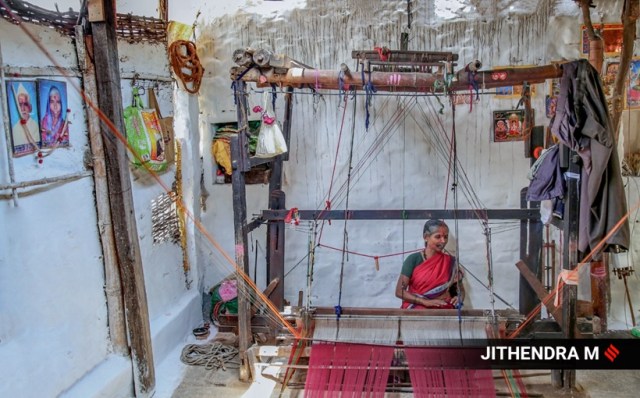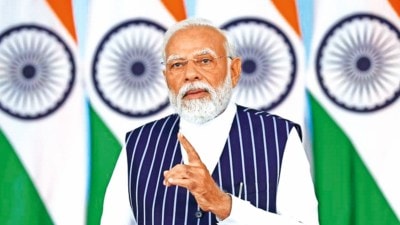Celebrating 10th National Handloom Day in 2024: Know the date, theme, history, significance and more
Discover the significance of National Handloom Day celebrated on August 7 in India, honoring the country's rich handloom heritage. Learn about the cultural impact, economic empowerment of artisans, and promotion of sustainable fashion through handloom textiles.
 Here is all you need to know about National Handloom Day, which is celebrated every year on August 7. (Express Photo by Jithendra M)
Here is all you need to know about National Handloom Day, which is celebrated every year on August 7. (Express Photo by Jithendra M)National Handloom Day 2024 Date and Significance: National Handloom Day was inaugurated by Prime Minister Narendra Modi in 2015 to honour the rich cultural heritage of handloom weavers.
The day celebrates the skills and craftsmanship of handloom weavers and aims to promote handloom products both domestically and internationally. This day underscores India’s commitment to preserving and promoting its unique handloom heritage while empowering weavers and ensuring their socio-economic well-being.
National Handloom Day serves as a platform to celebrate the diversity and richness of India’s handloom heritage. So, as we commemorate the 10th Handloom Day this year, in 2024, here is all you need to know about the day and the history and significance behind the day.
National Handloom Day 2024: Date and Theme
National Handloom Day is annually observed on August 7th. In 2024, it will be falling on a Wednesday. The theme of 2024 is yet to be officially announced; however, last year, the day was marked under the theme of “Handlooms for Sustainable Fashion,” thereby highlighting the importance of handloom weaving as an eco-friendly and sustainable alternative to machine-made fabrics.
Greetings on National Handloom Day! We take immense pride in the rich heritage and vibrant tradition of handlooms across our nation. We also cherish the efforts of our artisans and reiterate our commitment to be ‘Vocal for Local.’ pic.twitter.com/5M0LPxPFgr
— Narendra Modi (@narendramodi) August 7, 2024
National Handloom Day 2024: History
National Handloom Day in India has its roots in the Swadeshi Movement, which was launched on August 7, 1905, during India’s struggle for independence from British rule.
It was in response to the British government’s decision to partition Bengal, with handlooms becoming a powerful symbol of resistance against British rule. By promoting Indian crafts and empowering local artisans, it focused on reviving Indian culture and traditions and encouraging the use of Indian languages, arts, and crafts.
It aimed to increase self-sufficiency and reduce reliance on British goods by encouraging the use of indigenous products and protesting against British imports that undermined local industries; thereby, the handloom sector became intrinsically linked with the nation’s quest for independence.
 Source: Wikipedia Commons
Source: Wikipedia Commons
On August 15, 1947, the values promoted by the Swadeshi Movement were symbolically represented when Jawaharlal Nehru unfurled a hand-spun Khadi flag, marking India’s independence.
In modern times, the observance of National Handloom Day was inaugurated on August 7, 2015, by Prime Minister Narendra Modi, and this date was chosen to commemorate the Swadeshi Movement.
The day also honours the contributions of handloom weavers to India’s cultural heritage and economy to raise awareness about the importance of handloom products in India’s socio-economic development.
National Handloom Day 2024: Significance and Celebrations
National Handloom Day holds profound significance as a celebration of the country’s vibrant handloom heritage and to honour the skilled artisans and weavers whose craftsmanship has shaped India’s cultural identity for centuries.
It serves as a platform to promote sustainable fashion choices, raise awareness about the socio-economic importance of supporting local artisans, and highlight the environmental benefits of handloom textiles.
Beyond its cultural significance, National Handloom Day plays a crucial role in promoting sustainable practices in the textile industry, as they are inherently eco-friendly and involve minimal environmental impact compared to mass-produced fabrics.
By advocating for the adoption of handloom products, the observance encourages consumers to make informed choices that support ethical and environmentally responsible fashion.
 In urban centres, exhibitions and fashion shows are organised to showcase the versatility of handloom textiles, while in rural areas, where many handloom artisans reside, celebrations often take the form of cultural festivals and workshops.
In urban centres, exhibitions and fashion shows are organised to showcase the versatility of handloom textiles, while in rural areas, where many handloom artisans reside, celebrations often take the form of cultural festivals and workshops.
Additionally, educational programs and awareness campaigns are integral parts of the day celebrations, aiming to educate the public about the importance of supporting handloom products.
Hence, on National Handloom Day, celebrations across India are vibrant and diverse, reflecting the country’s deep-rooted appreciation for its rich textile traditions.
- 01
- 02
- 03
- 04
- 05































